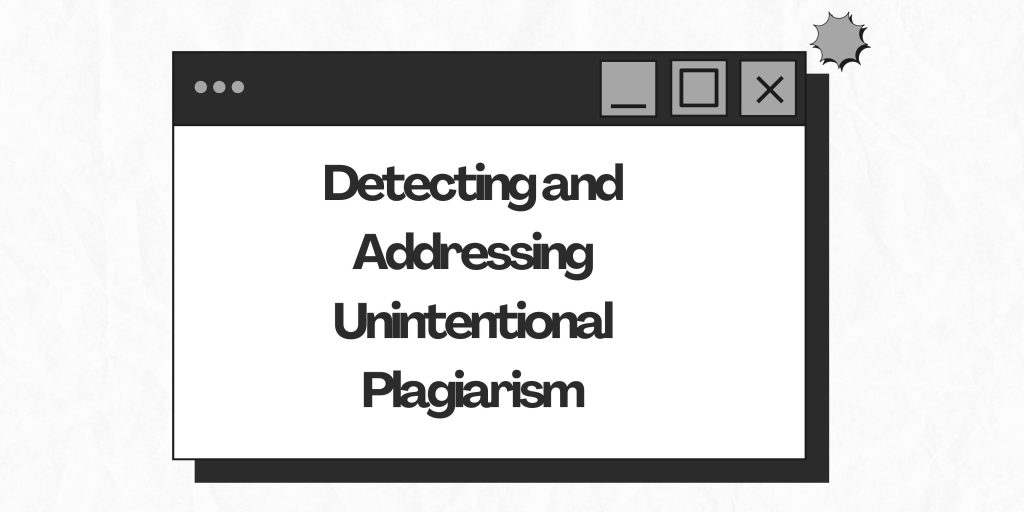Plagiarism, the act of using someone else’s work without proper attribution, is a serious offense with severe consequences. While intentional plagiarism is a deliberate act of dishonesty, unintentional plagiarism can occur due to a lack of knowledge or understanding of proper citation practices. It is essential to develop strategies for detecting and addressing unintentional plagiarism to maintain academic integrity and ensure the credibility of your work. In this blog post, we will explore the methods for detecting unintentional plagiarism, discuss the importance of proper citation, and provide practical tips for addressing and avoiding unintentional plagiarism. Additionally, we will highlight a real-world example to underscore the significance of these efforts.
Detecting Unintentional Plagiarism:
- Plagiarism Detection Software: Plagiarism detection software is a valuable tool for identifying instances of unintentional plagiarism. These software solutions compare your work against a vast database of sources to detect similarities and matches. They highlight potentially plagiarized content and provide a percentage of similarity to the original sources. Utilizing plagiarism detection software can help you identify unintentional plagiarism before submitting your work.
- Thorough Research and Note-Taking: Conducting thorough research and taking organized notes is crucial for avoiding unintentional plagiarism. When gathering information from sources, ensure that you clearly distinguish between your own thoughts and ideas and the material you are gathering. Make detailed notes, including the source information, to ensure accurate citation and attribution later.
- Double-Check Paraphrasing and Summarizing: Paraphrasing and summarizing are common techniques for incorporating information from sources into your work. However, they can lead to unintentional plagiarism if not done properly. When paraphrasing or summarizing, ensure that you express the ideas in your own words and provide proper citation to the original source. Compare your paraphrased or summarized content to the original to ensure you have not inadvertently used too many similar phrases or structures.
- Cross-Check Citations and References: Proper citation is essential for avoiding unintentional plagiarism. Double-check your citations and references to ensure accuracy and consistency. Make sure you have included all necessary information, such as author names, publication dates, and page numbers. Cross-check your citations against the original sources to ensure that you have attributed the information correctly.
Addressing and Avoiding Unintentional Plagiarism:
- Understand Citation Styles: Familiarize yourself with the citation style recommended in your academic or professional field. Different disciplines may use different styles, such as APA, MLA, Chicago, or Harvard. Understand the specific formatting guidelines for in-text citations, bibliographies, and reference lists. Properly applying the correct citation style helps you avoid unintentional plagiarism and ensures consistency throughout your work.
- Seek Clarification and Guidance: If you are unsure about proper citation practices or have questions about avoiding unintentional plagiarism, seek clarification and guidance from your professors, mentors, or writing centers. They can provide you with resources, examples, and support to help you understand and apply proper citation practices effectively.
- Use Quotation Marks for Direct Quotes: When directly quoting a source, use quotation marks to indicate that the words are not your own. Provide a proper in-text citation that includes the author’s name, publication year, and page number. This applies to both short and long quotes. By properly attributing direct quotes, you avoid unintentional plagiarism and maintain the integrity of your work.
- Keep Track of Your Sources: Maintain a clear record of the sources you consult during your research. Keep track of the author’s name, title of the work, publication year, page numbers, and any other relevant information. This helps you accurately cite and attribute information and avoid unintentional plagiarism.
Real-World Example:
A well-known example of unintentional plagiarism involves former Vice President Joe Biden. In 1987, Biden was running for the Democratic presidential nomination when it was discovered that he had plagiarized portions of a speech from British politician Neil Kinnock. This incident highlighted the importance of properly attributing sources and avoiding unintentional plagiarism, even for high-profile individuals in public positions.
Conclusion:
Detecting and addressing unintentional plagiarism is crucial for maintaining academic integrity and upholding the ethical standards of scholarly work. By utilizing plagiarism detection software, conducting thorough research, and double-checking paraphrasing and summarizing efforts, you can identify and rectify instances of unintentional plagiarism. Understanding citation styles, seeking guidance, using quotation marks for direct quotes, and keeping track of sources are essential strategies for addressing and avoiding unintentional plagiarism. Remember, the responsibility lies with you as a writer to ensure proper citation practices and attribution of sources, thus safeguarding the originality and integrity of your work.
